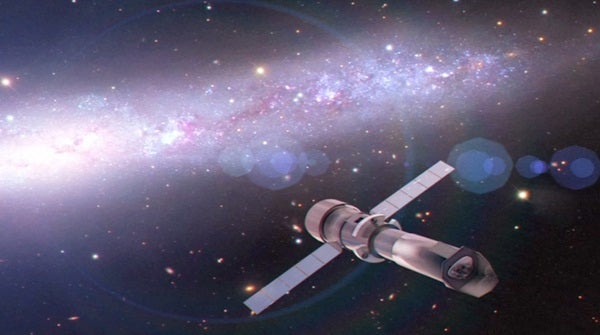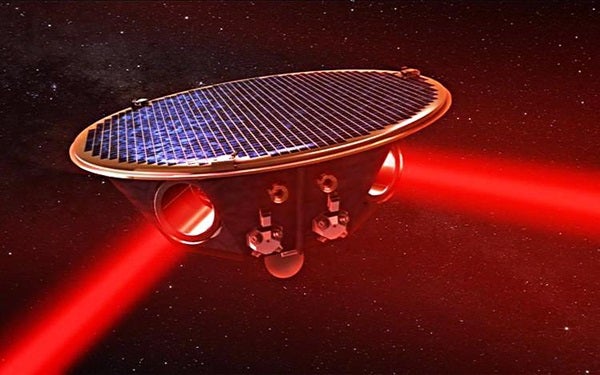Both topics will bridge fundamental astrophysics and cosmology themes by studying in detail the processes that are crucial to the large-scale evolution of the universe and its underlying physics.
How did ordinary matter assemble into the large-scale structures that we see today? How did black holes grow and shape the universe? These are some of the most important unanswered questions in modern astrophysics, and the next large ESA mission could provide critical answers.
“We are very pleased that ESA has decided that ‘The Hot and Energetic Universe’ will be one of its main mission targets,” said Nandra, spokesperson for the science theme and chair of the Athena collaboration. “We have a superb team of astrophysicists who made a compelling case for this exciting topic. But our job is not over — now we need to keep working to define the X-ray telescope that will provide us with the answers.”
Hot gas is actually the dominant form of ordinary matter in the universe and is responsible for the largest coherent structures that we know today: clusters of galaxies. With temperatures of more than 10 million degrees, the gas emits copiously at X-ray wavelengths. The key to understanding the formation and evolution of these structures is to build an X-ray space observatory that combines high sensitivity, high spectral resolution, and a wide field of view.
Athena was designed with exactly this goal in mind. With such a telescope, astronomers could obtain spectroscopic observations of distant galaxies and map the physical parameters of the largest bound objects — information that would dramatically advance scientists’ understanding of how hot gas structures started to assemble and form when the universe was in its infancy. Mapping the velocities, thermodynamics, and chemical composition of the hot gas and tracking it through cosmic time would also allow scientists to understand the complex astrophysical processes such as non-gravitational heating and turbulence which are crucial to understanding the development of ordinary matter structures.
With an X-ray telescope like Athena, the astronomers could also look even further back into the history of the universe to study its most energetic events and discover the first supermassive black holes, out to a time when the first galaxies were forming, less than 1 billion years after the Big Bang. Because of the extremely high temperatures and the huge energies deposited by matter as it falls into a black hole, X-ray emission is the most reliable and complete way of revealing such accreting monsters. Remarkably, processes originating close to the black hole seem able to influence galaxies and galaxy clusters on scales up to a billion times larger; this “cosmic feedback” is therefore an essential ingredient of galaxy evolution models, but it is not yet well understood.
Tracking the growth of supermassive black holes through cosmic time, in the earliest epoch of galaxy formation is impossible with current instrumentation. “We now have the X-ray optics technologies to provide the required leap in collecting area and angular resolution for wide field X-ray imaging,” said Nandra. “Over the past years at MPE, we have been continuously developing our X-ray detectors for exactly this opportunity. Now there is the chance to use them to map the X-ray Universe with exquisite sensitivity over unparalleled sky areas. The earliest supermassive black holes are within our grasp.”
Now that the science theme has been accepted by ESA, the next step will be a call for an X-ray observatory able to achieve the science goals. As the proposers of the theme and with the required technologies in hand, the Athena team members are confident their mission will make the grade. Once a mission concept has been selected, there is expected to be a period of three to four years to consolidate the technology development. It will take another 10 years or so to build the observatory. In 2028, Athena should start to reveal “The Hot and Energetic Universe” in unprecedented detail, and to provide the answer to that most basic question: Why does the universe look like it does today?
“We are very pleased with this decision. It will provide revolutionary research opportunities in astrophysics and fundamental physics,” said Karsten Danzmann, designated spokesperson of eLISA, director at the Max Planck Institute for Gravitational Physics (Albert Einstein Institute/AEI) and professor at the Leibniz University in Hannover, Germany. “We will immediately begin to optimize technologies already being developed for eLISA. These key technologies for eLISA will get their first test in space with the launch of ESA’s LISA Pathfinder (LPF) mission in 2015.”
“For the UK, the decision is great news,” said Henry Ward, who leads the University of Glasgow LPF and eLISA work. “The very significant UK Space Agency investment in developing the LISA Pathfinder payload will now bear fruit, and with eLISA we can look forward to a rich scientific output from what promises to be one of the most important astronomical observatories of our time.”
The observation of gravitational waves in space will provide powerful insight into the fundamentals of gravity, and into Einstein’s theory that predicted the waves in 1916. A gravitational wave observatory in space will open up hidden chapters in the history of the universe by listening to the waves made by the earliest black holes, by thousands of binary stars, and probably by the Big Bang itself. By seeing how the waves from early black holes are stretched out as they move toward us through the expanding Universe, the observatory will even study the mysterious dark energy.
The proposed eLISA mission is designed to be complementary to existing and planned ground-based gravitational wave observatories. Earth- and space-based gravitational wave observatories target different parts of the gravitational wave spectrum, searching for ripples in the fabric of space-time created by the most violent events in the universe, such as the coalescence of black holes. Gravitational waves carry with them information about their origins and about the nature of gravity that cannot be obtained using other astronomical tools.











